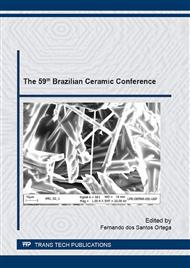p.159
p.165
p.171
p.176
p.181
p.187
p.195
p.200
p.206
Properties of ZrO2(Y2O3) Used as Metal-Free Dental Restorations
Abstract:
In this work, pre-sintered zirconia ZrO2(Y2O3) ceramics were characterized aiming its acceptance in standard ISO 6872:2015 (Dentistry-Ceramic Materials). Pre-sintered zirconia blocks were sintered at 1450oC, 1500oC, 1530oC or 1600oC. Sintered samples were sanded, polished and characterized by relative density, crystalline phase, microstructure, hardness, fracture toughness, bending strength, translucence and dilatometry. The results indicated that the ceramic studied presents hardness superior to 1200HV, fracture toughness of 8MPa.m1/2 and bending strength superior to 900MPa. Zirconia sintered at temperature of 1600oC, presented exaggerated grain growth which reduces the material toughness. With the porosity decreasing and the grain growth increasing it happens the increase of translucence, but the mechanical aspects must be analyzed carefully, in order to establish zirconia reliability for using it in dental prostheses.
Info:
Periodical:
Pages:
181-186
Citation:
Online since:
November 2016
Keywords:
Price:
Сopyright:
© 2017 Trans Tech Publications Ltd. All Rights Reserved
Share:
Citation:


